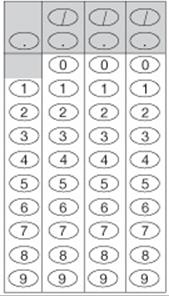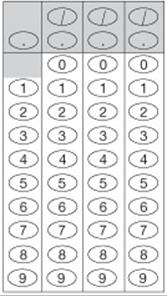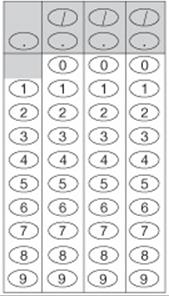SAT Test Prep
CHAPTER 11
ESSENTIAL ALGEBRA 2 SKILLS
1. Sequences
2. Functions
3. Transformations
4. Variation
5. Data Analysis
6. Negative and Fractional Exponents

Lesson 1: Sequences
Analyzing Sequences
A sequence is just a list of numbers, each of which is called a term. An SAT math question might ask you to use a sequential pattern to solve a problem, such as “How many odd numbers are in the first 100 terms of the sequence 1, 2, 3, 1, 2, 3, …?”
An SAT sequence question usually gives you the first few terms of a sequence or the rule for generating the sequence, and then asks you either to find a specific term in the sequence (as in “What is the 59th term of this sequence?”) or to analyze a subset of the sequence (as in “What is the sum of the first 36 terms of this sequence?”). To tackle sequence problems:
1. Use the pattern or rule to write out the first six to eight terms of the sequence.
2. Try to identify the pattern in the sequence. Notice in particular when the sequence begins to repeat itself, if it does.
3. Use this pattern, together with whole-number division (Chapter 7, Lesson 7), if it”s helpful, to solve the problem.
Example:
![]()
The first three terms of a sequence are shown above. Each term after the second term is found by dividing the preceding term by the term before that. For example, the third term is found by dividing the second term, 2, by the first term, –1. What is the value of the 218th term of this sequence?
Don”t panic. You won”t have to write out 218 terms! Just write out the first eight or so until you notice that the sequence begins to repeat. The fourth term is ![]() , the fifth term is
, the fifth term is ![]() , and so on. This gives the sequence
, and so on. This gives the sequence ![]() , –1, 2, ….
, –1, 2, ….
Notice that the first two terms of the sequence, –1 and 2, have come back again! This means that the first six terms in the sequence, the underlined ones, will just repeat over and over again. Therefore, in the first 218 terms, this six-term pattern will repeat ![]() times, or 36 with a remainder of 2. So, the 218th term will be the same as the second term in the sequence, which is 2.
times, or 36 with a remainder of 2. So, the 218th term will be the same as the second term in the sequence, which is 2.
Example:
![]()
If the sequence above repeats as shown, what is the sum of the first 43 terms of this sequence?
Since the sequence clearly repeats every three terms, then in 43 terms this pattern will repeat ![]() (with remainder 1) times. Each full repetition of the pattern –1, 1, 0 has a sum of 0, so the first 14 repetitions have a sum of 0. This accounts for the sum of the first
(with remainder 1) times. Each full repetition of the pattern –1, 1, 0 has a sum of 0, so the first 14 repetitions have a sum of 0. This accounts for the sum of the first ![]() terms. But you can”t forget the “remainder” term! Since that 43rd term is –1, the sum of the first 43 terms is –1.
terms. But you can”t forget the “remainder” term! Since that 43rd term is –1, the sum of the first 43 terms is –1.
You won”t need to use the formulas for “arithmetic sequences” or “geometric sequences” that you may have learned in algebra class. Instead, SAT “sequence” questions simply require that you figure out the pattern in the sequence.
Concept Review 1: Sequences
1. What is a sequence?
2. If the pattern of a sequence repeats every six terms, how do you determine the 115th term of the sequence?
3. If the pattern of a number sequence repeats every four terms, how do you find the sum of the first 32 terms of the sequence?
4. If a number sequence repeats every five terms, how do you determine how many of the first 36 terms are negative?
5. What is the 30th term of the following sequence? ![]()
6. The first term in a sequence is 4, and each subsequent term is eight more than twice the preceding term. What is the value of the sixth term?
7. The word SCORE is written 200 times in a row on a piece of paper. How many of the first 143 letters are vowels?
8. The third term of a sequence is x. If each term in the sequence except the first is found by subtracting 3 from the previous term and dividing that difference by 2, what is the first term of the sequence in terms of x?
9. A 60-digit number is created by writing all the positive integers in succession beginning with 1. What is the 44th digit of the number?
SAT Practice 1: Sequences
1. The first term in a sequence is x. Each subsequent term is 3 less than twice the preceding term. What is the fifth term in the sequence?
![]()
![]()
![]()
![]()
![]()
![]()
2. In the sequence above, each term after the first is equal to the previous term times a constant. What is the value of the 13th term?
(A) 27
(B) 28
(C) 29
(D) 210
(E) 211
3. The first term in a sequence is 400. Every subsequent term is 20 less than half of the immediately preceding term. What is the fourth term in the sequence?

4. In the number ![]() , the digits 148285 repeat indefinitely. How many of the first 500 digits after the decimal point are odd?
, the digits 148285 repeat indefinitely. How many of the first 500 digits after the decimal point are odd?
(A) 83
(B) 166
(C) 167
(D) 168
(E) 332
![]()
5. In the sequence above, the first 5 is followed by one 6, the second 5 is followed by two 6s, and so on. If the sequence continues in this manner, how many 6s are there between the 44th and 47th appearances of the number 5?
(A) 91
(B) 135
(C) 138
(D) 182
(E) 230
6. The first term in a sequence is –5, and each subsequent term is 6 more than the immediately preceding term. What is the value of the 104th term?
(A) 607
(B) 613
(C) 618
(D) 619
(E) 625
7. What is the units digit of 336?
(A) 0
(B) 1
(C) 3
(D) 7
(E) 9
![]()
8. After the first term in the sequence above, each odd-numbered term can be found by multiplying the preceding term by three, and each even-numbered term can be found by multiplying the previous term by 1/3. What is the value of the 24th term?

9. The first two terms of a sequence are 640 and 160. Each term after the first is equal to one-fourth of the previous term. What is the value of the sixth term?

![]()
10. After the first two terms in the sequence above, each odd-numbered term can be found by dividing the previous term by 2. For example, the third term is equal to ![]() . Each even-numbered term can be found by adding 8 to the previous term. For example, the fourth term is equal to
. Each even-numbered term can be found by adding 8 to the previous term. For example, the fourth term is equal to ![]() . How many terms are there before the first noninteger term?
. How many terms are there before the first noninteger term?
(A) 3
(B) 4
(C) 5
(D) 6
(E) 7
![]()
11. The first three terms of a sequence are given above. If each subsequent term is the product of the preceding two terms, how many of the first 90 terms are negative?
(A) 16
(B) 30
(C) 45
(D) 60
(E) 66
Answer Key 1: Sequences
Concept Review 1
1. A sequence is simply a list of numbers, each of which is called a “term.”
2. If the sequence repeats every six terms, you can find the 115th term by finding the remainder when 115 is divided by 6. Since ![]() equals 19 with a remainder of 1, the 115th term will be the same as the first term.
equals 19 with a remainder of 1, the 115th term will be the same as the first term.
3. Begin by finding the sum of the repeating pattern. Next, determine how many times the pattern occurs in the first 32 terms: ![]() times. Then multiply the sum of the pattern by 8 to obtain the sum.
times. Then multiply the sum of the pattern by 8 to obtain the sum.
4. Count the number of negative terms in each repetition of the pattern, then find how many times the pattern repeats in the first 36 terms. Since ![]() with a remainder of 1, the pattern repeats 7 times and is 1 term into the eighth repetition. Multiply the number of negative terms per repetition by 7, and if the first term of the sequence is negative, add 1 to the total.
with a remainder of 1, the pattern repeats 7 times and is 1 term into the eighth repetition. Multiply the number of negative terms per repetition by 7, and if the first term of the sequence is negative, add 1 to the total.
5. This is a geometric sequence. Each term is the previous one times ![]() . The first term of the sequence is 3–2, and the 30th term is
. The first term of the sequence is 3–2, and the 30th term is ![]() .
.
6. The first term is 4. Second: ![]() . Third:
. Third: ![]() . Fourth:
. Fourth: ![]() . Fifth:
. Fifth: ![]() . Sixth:
. Sixth: ![]() .
.
7. The pattern repeats every five terms, and each repetition contains two vowels. Since ![]() with a remainder of 3, the first 143 letters contain
with a remainder of 3, the first 143 letters contain ![]() vowels plus the one vowel in the first three letters of the word SCORE, for a total of
vowels plus the one vowel in the first three letters of the word SCORE, for a total of ![]() .
.
8. Work backwards: x was found by subtracting 3 from the second term and dividing by 2. Therefore, multiply x by 2 and add 3 to get the second term: ![]() . Repeat to find the first term:
. Repeat to find the first term: ![]() .
.
9. The integers 1 through 9 represent the first 9 digits, and 10 through 19 represent the next 20 digits. Each integer thereafter contains 2 digits. 26 represents the 42nd and 43rd digits, so 2 is the 44th digit.
SAT Practice 1
1. D The first term of the sequence is x. The second term is ![]() . The third term is
. The third term is ![]() . The fourth term is
. The fourth term is ![]() . The fifth term is
. The fifth term is ![]() .
.
2. C Each term in the sequence is the previous term times 2. The first term, ![]() is equal to 2–3. To find the value of the 13th term, multiply the first term by 2 twelve times or by 212 to get your answer.
is equal to 2–3. To find the value of the 13th term, multiply the first term by 2 twelve times or by 212 to get your answer.
![]()
3. 15 The first term is 400, after which each term is 20 less than 1/2 the previous term. The second term is ![]() . The third term is
. The third term is ![]() . The fourth term is
. The fourth term is ![]() .
.
4. C The sequence contains a repeating six-term pattern: 148285. To find out how many times the pattern repeats in the first 500 terms, divide 500 by ![]() . By the 500th term, the pattern has repeated 83 full times and is
. By the 500th term, the pattern has repeated 83 full times and is ![]() of the way through the 84th repetition. Each repetition of the pattern contains two odd digits, so in the 83 full repetitions there are
of the way through the 84th repetition. Each repetition of the pattern contains two odd digits, so in the 83 full repetitions there are ![]() odd digits. In the first
odd digits. In the first ![]() of the pattern there is one odd digit. Therefore there are
of the pattern there is one odd digit. Therefore there are ![]() odd digits.
odd digits.
5. B There will be ![]() between the 44th and 47th appearances of 5.
between the 44th and 47th appearances of 5.
6. B In this arithmetic sequence you must add 6 to each term. To get from the 1st to the 104th term you will add 103 terms, or 103 6s. The value of the 104th term is thus ![]() .
.
![]() ;
;![]() ;
;![]() ;
; ![]() ;
;![]() ;
;![]() . The units digits repeat in the pattern 3, 9, 7, 1, 3, 9, 7, 1, …, and
. The units digits repeat in the pattern 3, 9, 7, 1, 3, 9, 7, 1, …, and ![]() nine full repetitions. Since it goes in evenly, it must fall on the last term of the pattern, which is 1.
nine full repetitions. Since it goes in evenly, it must fall on the last term of the pattern, which is 1.
8. 70 The pattern alternates back and forth between 210 and 70. Each odd-numbered term is 210 and each even-numbered term is 70, so the 24th term is 70.
9. 5/8 or .625 The first term of the sequence is 640. Each term thereafter is 1/4 of the immediately preceding term. The first six terms are ![]() .
.
10. D The third term of the sequence is ![]() . The fourth term is
. The fourth term is ![]() . The fifth term is
. The fifth term is ![]() . The sixth term is
. The sixth term is ![]() . The seventh term is
. The seventh term is ![]() , which is the first noninteger term.
, which is the first noninteger term.
11. D In this problem, only the signs of the terms matter. The first term is negative and the second is positive. The third term is ![]() . The fourth term is
. The fourth term is ![]() . The fifth term is
. The fifth term is ![]() . The sixth term is
. The sixth term is ![]() . The first six terms of the sequence are: –,+,–,–,+,–. The pattern –,+,– repeats every three terms. In the first 90 terms, the pattern repeats
. The first six terms of the sequence are: –,+,–,–,+,–. The pattern –,+,– repeats every three terms. In the first 90 terms, the pattern repeats ![]() times. Each repetition contains two negative numbers, so in 30 full repetitions there are
times. Each repetition contains two negative numbers, so in 30 full repetitions there are ![]() negative numbers.
negative numbers.